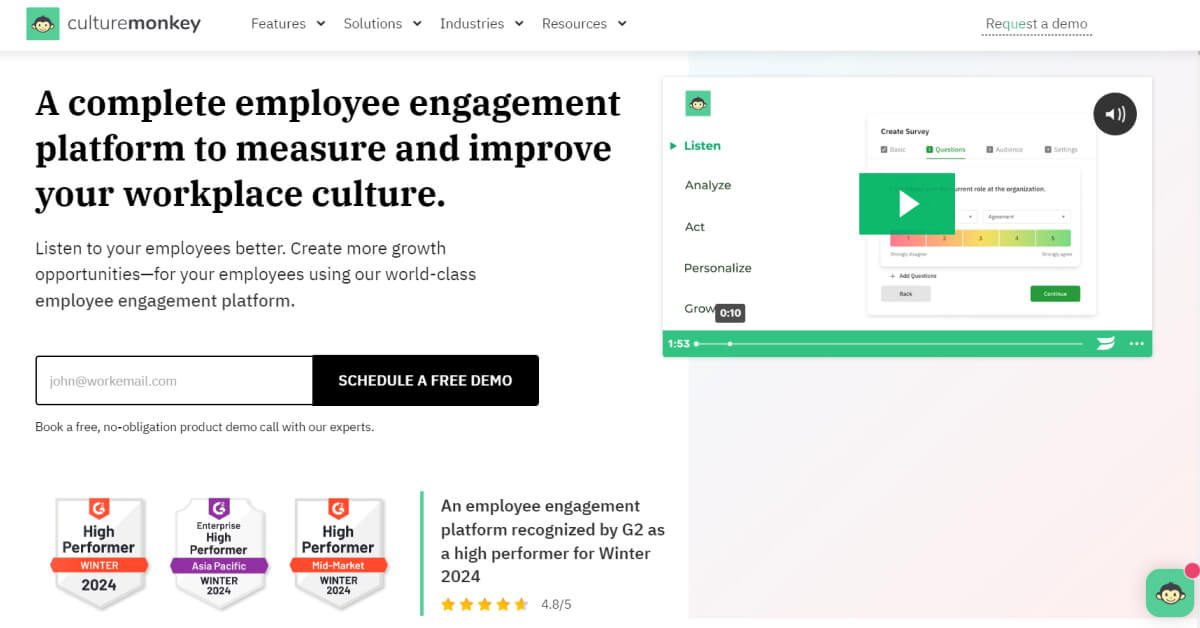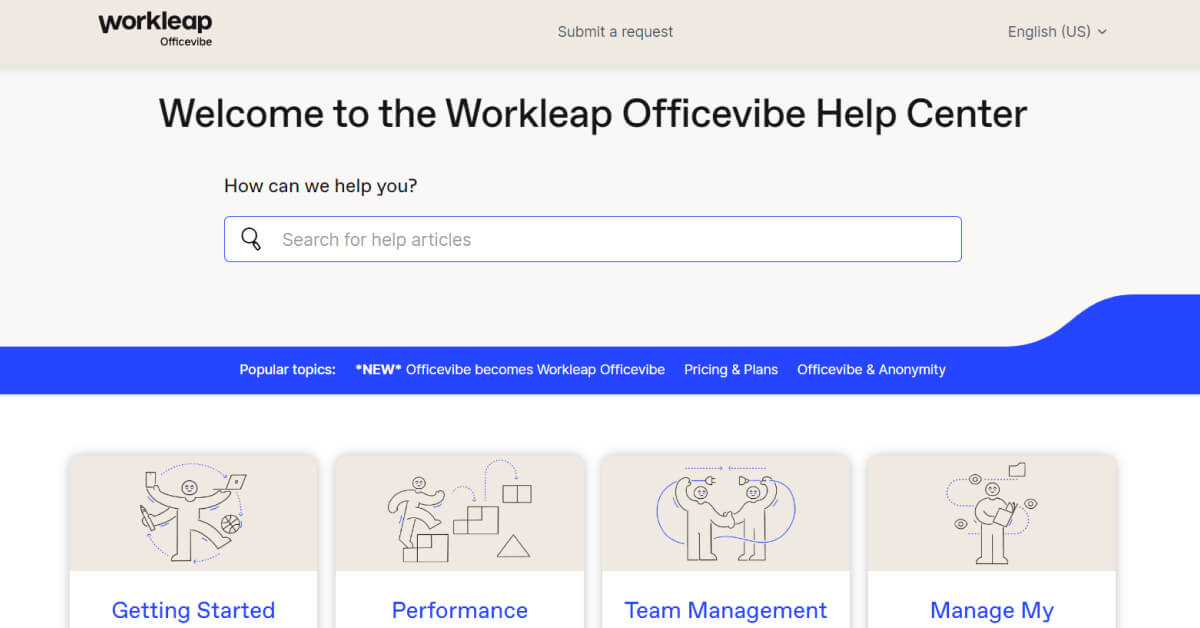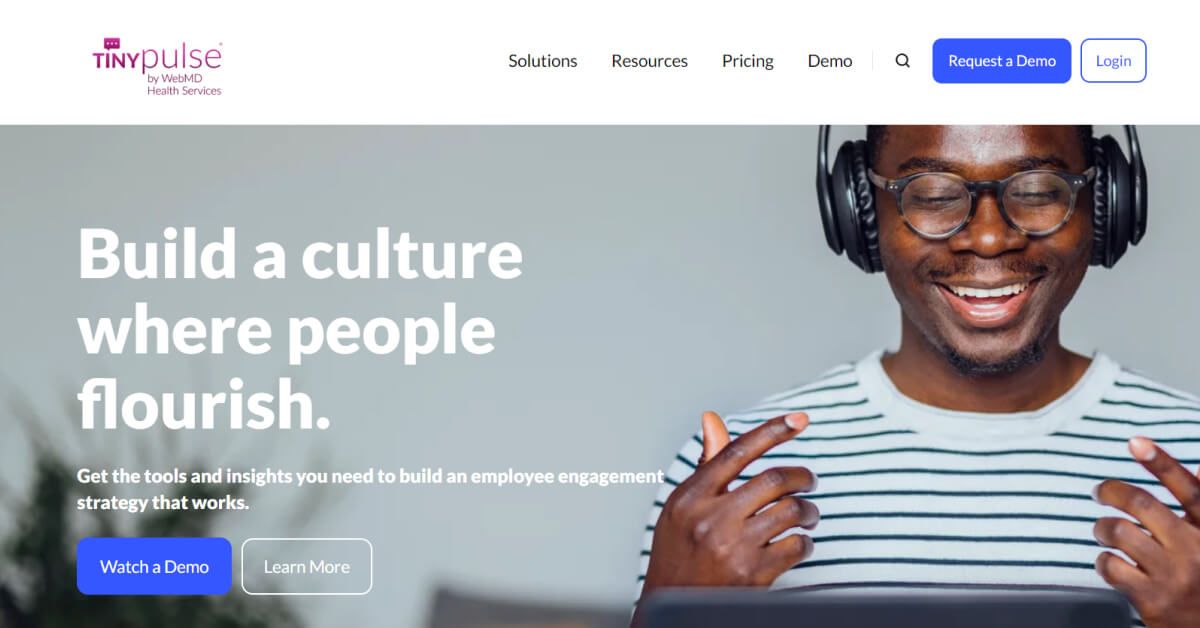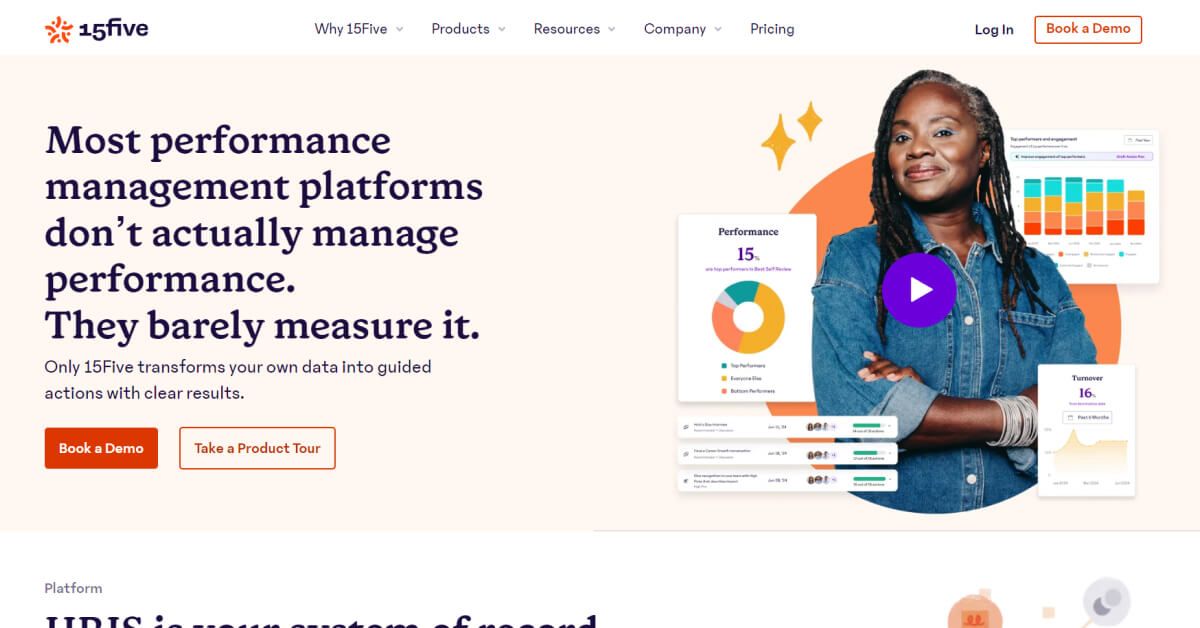What is employee voice? How can continuous listening improve employee engagement?

Imagine your company is about to roll out a big marketing campaign for a new product. The creative team is excited, leadership is on board, and everything seems perfect—except one junior employee raises a small concern.
They mention that the campaign’s messaging might unintentionally alienate a key customer demographic. It’s easy to brush off; after all, they’re new and the plan is already in motion. But what if that one voice was the insight that could prevent a major PR blunder?
Ignoring employee voices, no matter how small or from where they come, could result in costly mistakes. In today’s workplace, encouraging employees to speak up and actually listening can be the difference between a marketing win and a damaging misstep.
When it comes to employee voice, every opinion counts.
What is employee voice in the workplace?

Employee voice is about giving the employees the power to express their thoughts, opinions, and ideas within the workplace. It's like opening the windows of a stuffy room and letting in a refreshing breeze of fresh perspectives.
Employees feel that their voices matter, feel respected, and empowered when they have a company culture where two-way communication is respected.
Think of it as a place where employees are not just passive recipients of information but active contributors to every process. It goes beyond the traditional top-down approach where only senior level employees make the decisions encouraging a culture of openness and collaboration.
Whether it's through surveys, suggestion boxes, team meetings, or digital platforms, employee feedback provides an avenue for individuals to share their experiences, provide new ideas, and contribute their unique insights. So, employers need to have an employee voice strategy in place.
What are the elements of employee voice?
The concept of employee voice encompasses a multifaceted approach to amplifying the opinions, perspectives, and insights of the workforce within an organizational setting.
There are a few pivotal elements that constitute the framework of employee voice, each playing a distinct role in shaping a company culture that values and leverages the collective wisdom of its employees.
- Leadership responsiveness: The effectiveness of employee voice increases when leaders actively respond to feedback. By taking tangible actions, leadership fosters trust and shows a commitment to improvement, reinforcing the value of employee contributions.
- Cultural inclusivity: Employee voice thrives in an inclusive environment where diverse perspectives are celebrated. Creating a culture that values varied experiences encourages open expression without fear of judgment.
- Feedback mechanisms: Robust feedback systems, like performance reviews and open discussions, give employees structured opportunities to share concerns and aspirations. This ensures a balanced exchange of guidance and employee input.
- Recognition of contributions: Acknowledging employee achievements, big or small, fosters a positive culture. Recognition motivates employees to engage more deeply, knowing their efforts are valued and contribute to the organization’s success.
- Empowerment and autonomy: Empowering employees to make decisions and take ownership of their work encourages innovation and builds confidence. Autonomy strengthens their connection to their roles and the company’s goals.
- Open communication channels: Maintaining transparent communication through town halls, suggestion boxes, and digital platforms allows employees to freely share ideas. Open channels ensure their voices lead to meaningful change, fostering a sense of belonging.
- Actionable insights integration: Implementing a system to analyze and integrate employee feedback into decision-making processes ensures their ideas have a tangible impact. This practice demonstrates that employee input is not only heard but actively shapes organizational performance.
- Continuous dialogue: Regularly engaging employees in two-way conversations fosters a collaborative atmosphere. Encouraging ongoing discussions rather than one-time feedback initiatives keeps the employee voice dynamic and relevant.
- Training for expression: Providing employees with training on effective communication skills empowers them to articulate their ideas and concerns confidently. This creates an environment where every voice has the opportunity to be heard clearly.
- Safe escalation pathways: Establishing secure and anonymous ways for employees to raise sensitive issues promotes trust. Clear escalation channels encourage individuals to voice concerns without fear of retaliation or judgment.
Types of employee voice

Employee voice takes various forms within an organization, each contributing uniquely to improving communication, engagement, and business outcomes. Understanding these different types of employee voice allows companies to create a culture where all forms of feedback are encouraged and valued.
- Formal voice: Formal employee voice includes structured channels such as surveys, performance reviews, and suggestion boxes. These mechanisms are designed for gathering insights in an organized manner, ensuring that every employee has the opportunity to share feedback within a clear framework.
- Informal voice: Informal voice arises during day-to-day interactions, such as casual conversations or impromptu discussions with managers. While less structured, informal voice can often provide immediate and unfiltered feedback that may be overlooked in more formal settings.
- Advocacy voice: This type occurs when employees actively advocate for their peers or teams. Advocacy voice is often seen in situations where employees push for change or improvements on behalf of their colleagues, focusing on collective concerns rather than individual issues.
- Consultative voice: Consultative voice involves employees being asked for their input during decision-making processes. Leaders seek opinions on strategic initiatives, fostering a sense of inclusion by involving employees in shaping company policies or future directions.
- Challenging voice: Challenging voice occurs when employees feel empowered to question decisions, policies, or existing processes. It’s a constructive form of dissent that encourages critical thinking and innovation, helping organizations avoid complacency and continuously improve.
- Digital voice: Digital voice emerges through online platforms, such as internal social networks, collaboration tools, or employee portals. These platforms provide a space for employees to share ideas, concerns, and feedback in real-time, fostering benefits of employee voice including the culture of open dialogue across all levels.
- Leadership voice: This type involves employees directly engaging with senior leadership during events like employee town hall meetings or Q&A sessions. Leadership voice allows employees to address organizational issues and share insights directly with decision-makers, bridging gaps between staff and leadership.
- Project-based voice: In project-based settings, employees contribute ideas and feedback specific to ongoing tasks or initiatives. This form of voice ensures that team members actively shape the outcomes of their projects, promoting ownership and improved employee retention.
- Community voice: Community voice extends beyond workplace discussions, focusing on employees advocating for social or community-related initiatives. This reflects their alignment with the organization's values and reinforces a culture of responsibility and collective well-being.
Importance of employee voice in the workplace
The importance of cultivating and amplifying the voices of those within the workforce cannot be overstated. Here, we delve into key points underscoring the significance of the employee voice in fostering a thriving workplace environment:
- Enhanced engagement: When employees feel that their opinions matter, they are more likely to be engaged in their work. An engaged workforce is a more productive and committed workforce, driving overall organizational success.
- Boosted morale: Recognizing and valuing the contributions of employees through listening and acting upon their feedback can significantly boost morale. A positive workplace culture is often marked by a sense of being heard and appreciated.
- Heightened employee satisfaction: Actively seeking and implementing feedback demonstrates an organization's commitment to continuous improvement. This commitment, in turn, leads to higher employee satisfaction, contributing to reduced turnover rates.
- Trust building: Trust is the bedrock of any successful workplace. When employees see that their opinions are valued and acted upon, a culture of trust flourishes, laying the groundwork for stronger employer-employee relationships.
- Adaptability and resilience: In an ever-evolving business landscape, the ability to adapt is paramount. The employee voice provides an invaluable resource for staying attuned to market shifts and emerging trends, enabling organizations to navigate change with resilience.
- Talent retention: When employees feel heard and valued, they are more likely to remain loyal to the organization. This sense of loyalty reduces turnover rates and ensures that the organization retains its top talent, leading to sustained growth and stability.
Employee voice in hybrid work models and future trends
Hybrid work models have redefined how organizations approach employee voice. With dispersed teams, companies now rely heavily on digital platforms to maintain engagement and communication.
Tools like virtual town halls, instant messaging apps, and cloud-based feedback systems ensure employees can share their insights regardless of location.
Hybrid setups also demand more intentional efforts to create a sense of belonging, making employee voice a critical component in bridging the gap between in-office and remote staff.
Future trends of employee voice
The future of employee voice lies in leveraging data and AI to enhance personalization and predict trends. AI-powered sentiment analysis and predictive analytics will enable companies to identify emerging concerns before they escalate.
As technology evolves, organizations will integrate more immersive tools like virtual reality for engaging feedback sessions, ensuring companies value every voice and their voice remains at the forefront of decision-making in a fast-changing world.
Benefits of listening to employee voice

By embracing employee voice, companies tap into a vast pool of untapped potential. They unlock a wealth of innovative ideas, identify and address problems early on, and foster a sense of ownership and loyalty among employees. Here are some of the top benefits of listening to employee voice.
- Early problem identification: Employees are often the first to notice workplace inefficiencies or issues. Encouraging their voice helps surface problems early, allowing for timely intervention. Whether it's a process bottleneck or potential customer dissatisfaction, addressing these concerns proactively prevents escalation and fosters continuous improvement.
- Strengthened communication and trust: Listening attentively to employees builds mutual trust and transparency. When employees know their opinions are valued, they feel more comfortable sharing their thoughts. This open communication strengthens teamwork and fosters a positive organizational culture.
- Enhanced employee well-being: Acknowledging employee concerns fosters a supportive environment, improving their overall well-being. Listening reduces stress, promotes mental health, and strengthens the sense of security and belonging in the workplace, contributing to a healthier workforce.
- Increased employee loyalty: When employees feel their voice matters, they develop greater loyalty to the company. Implementing their suggestions strengthens their emotional investment, reducing turnover and creating a stable, dedicated workforce committed to the organization’s success.
- Enhanced employee development: Feedback offers valuable insights into employees’ career goals and aspirations. By aligning training programs with these goals, companies foster professional growth, boosting both job satisfaction and morale.
- Positive employer branding: Organizations that listen to employees build a strong reputation as desirable workplaces. Satisfied employees spread positive word-of-mouth, attracting top talent and enhancing the company’s image in the market and among clients.
Challenges companies face with employee voice
While fostering employee voice brings numerous benefits, companies often face several challenges in creating an environment where employees feel empowered to speak up. Here are key obstacles organizations encounter:
- Fear of repercussions: One of the biggest challenges is that employees may fear negative consequences for voicing concerns or offering feedback. This fear can be rooted in past experiences or a lack of trust in leadership, leading to a reluctance to share honest opinions.
- Leadership resistance to change: Even when employees voice their ideas, leadership may resist implementing changes, especially if feedback challenges established norms or existing processes. This resistance can stifle innovation and demotivate employees from contributing further.
- Lack of clear feedback channels: Many companies struggle with providing clear, structured ways for employees to voice their thoughts. Without proper mechanisms like anonymous surveys or regular feedback sessions, employee voice initiatives can become fragmented, and important insights may be lost.
- Ineffective action on feedback: Another challenge is turning feedback into meaningful action. Companies that gather employee input but fail to act on it risk disengaging their workforce, as employees may feel their voice doesn’t have an impact.
- Cultural barriers in global organizations: For multinational companies, cultural differences can hinder employee voice initiatives. Employees in certain regions may be less inclined to share opinions openly due to cultural norms, creating inconsistencies in feedback across locations.
Example of employee voice in the workplace

Here are real-world examples of employee voice in action from well-known companies:
Microsoft's "Hackathon" for innovation
Microsoft encourages employees to participate in its annual company-wide Hackathon, where employees across all departments can voice their ideas for new products and solutions. One of the most famous outcomes was the creation of Seeing AI, an app designed to help visually impaired individuals navigate their surroundings. This initiative highlights how employee voice can drive innovation and impact society.
General Electric's "Brilliant YOU" initiative
GE launched the "Brilliant YOU" platform to empower employees to share ideas and feedback on improving diversity, inclusion, and engagement within the company. Employees have shaped internal policies, such as enhanced parental leave and mentorship programs, reflecting how employee voice can influence company culture and leadership strategies.
Adobe’s “Kickbox” program
Adobe introduced its Kickbox initiative to empower employees at all levels to develop and pitch innovative ideas. Employees are given a physical “red box” containing instructions, a prepaid credit card, and resources to explore their concepts. This initiative has led to new product ideas and operational improvements, showing how employee voice can directly impact innovation and the company’s growth.
Zappos' Holacracy approach
Zappos embraced Holacracy, a management system that flattens the hierarchy and empowers employees to have a greater voice in decision-making. Employees can pitch ideas, take ownership of projects, and make critical decisions without the constraints of traditional hierarchy, fostering a culture where every voice matters.
8 Best ways for accessing employee voice at work
Accessing employee voice at work is crucial for creating an inclusive and engaging workplace culture. Here are eight of the best ways to ensure employees have a voice:
1) Open-door policy
Implement an open-door policy where employees do not feel uncomfortable approaching managers and leaders with their thoughts and concerns. This creates an environment of trust and accessibility, allowing employees to share their ideas and feedback directly with those who have the power to act upon them.
2) Regular feedback and performance reviews
Incorporate regular feedback and performance review processes to provide structured opportunities for employees to express their thoughts and aspirations. These sessions should be two-way conversations, allowing employees to share their achievements, challenges, and areas for growth, while managers provide constructive feedback and support.
3) Employee surveys
Conduct anonymous surveys to gather comprehensive feedback on various aspects of the workplace, such as job satisfaction, organizational culture, and communication effectiveness. Surveys provide a safe space for employees to express their opinions, identify areas of improvement, and suggest innovative ideas.
4) Employee resource groups (ERGs)
Establish ERGs representing different demographics, interests, or affinity groups within the organization. They provide a platform for employees to connect, share experiences, and voice their unique perspectives. It enables employees to contribute their ideas, collaborate on initiatives, and offer feedback on diversity, inclusion, and employee well-being.
5) Idea generation platforms
Implement digital platforms or dedicated channels where employees can submit their ideas, suggestions, and solutions. These platforms encourage innovation and creativity, allowing employees to share their expertise and contribute to problem-solving efforts.
6) Surveys and feedback platforms
Surveys are a common and effective method to gather anonymous feedback from employees. Whether conducted periodically or after specific events, surveys provide a structured way to assess employee opinions, satisfaction levels, and suggestions for improvement.
7) Town hall meetings
Town hall meetings involve gathering all employees together for open discussions and updates. These meetings can be held in person or virtually. They provide an opportunity for senior leaders to share important information, listen to employee concerns, and answer questions. They promote transparency, allow for direct interaction, and enable employees to have their voices heard by top-level management.
8) Digital collaboration and idea-sharing platforms
With the rise of technology, digital platforms have become popular for facilitating employee voices. These platforms, such as internal social networks or collaboration tools, create virtual spaces where employees can openly share ideas, ask questions, and engage in discussions.
How to encourage employee voice in the workplace?

As an organization, there are a plethora of things you can do to ensure that employees feel confident to voice their opinions or problems in the workplace. Here are some ideas that will help you form an employee voice strategy in your organization.
- Create a safe and supportive environment: Foster an inclusive and psychologically safe environment where employees do not feel uncomfortable while expressing their opinions without fear of retribution.
- Actively listen: Demonstrate a genuine interest in employee opinions by actively listening. Engage in meaningful conversations, ask open-ended questions, and provide undivided attention when employees share their thoughts.
- Recognize and celebrate contributions: Acknowledge and appreciate employees' ideas and contributions. Recognize your employees and celebrate their innovative solutions, improvements, or initiatives.
- Empower employee-led initiatives: It is easy to encourage employees to take the lead in driving initiatives, such as setting up employee resource groups, organizing knowledge-sharing sessions, or spearheading innovation projects.
- Establish a formal recognition program: Implement a formal program to recognize and reward employees who actively contribute their ideas or voice their opinions. This creates a positive feedback loop, motivating employees to continue sharing their insights.
- Set up mentorship programs: Create mentorship programs that facilitate open communication between employees and mentors. This supportive relationship encourages employees to seek guidance and share their perspectives in a more informal setting.
What is a town hall meeting?
A town hall meeting is an open forum where leadership and employees come together to discuss important topics, share updates, and address concerns. These meetings provide a platform for employees to directly engage with management, fostering transparent communication across all levels of the organization.
Town halls offer a face-to-face or virtual opportunity for employees to ask questions in real-time, ensuring that their voices are heard and acknowledged. They also help clarify the company’s strategic direction, goals, and any upcoming changes, aligning the entire workforce.
Town hall meetings promote a sense of community by creating a space for open dialogue, allowing employees to feel more connected to the organization’s mission. Regularly hosting these meetings not only enhances employee engagement but also encourages leadership accountability, ensuring that feedback is considered and acted upon.
The link between employee voice and employee engagement

Employee voice and employee engagement share a strong and interconnected relationship. When employees have a voice and their opinions are heard, it positively impacts their level of engagement within the organization.
Employee voice empowers individuals, providing a sense of control over their work environment and fueling motivation, commitment, and willingness to go the extra mile. So, as employees feel valued and respected through their voice being heard, it enhances their sense of belonging and connection to the organization, leading to higher engagement and loyalty.
Being able to voice their opinions also fosters a culture of ownership, where employees are involved in decision-making processes and not just a mere part of the workforce. This involvement cultivates a greater sense of commitment and dedication to their roles and the organization's goals.
Furthermore, employee voice relies on open and transparent communication channels. When organizations actively listen to their employees, respond to their concerns, and implement their suggestions, it builds trust and strengthens workplace relationships and engagement.
What is the employee voice strategy?
An employee voice strategy is a structured approach designed to encourage and amplify employees’ perspectives, ideas, and feedback within an organization. It promotes open communication and aligns employee input with organizational goals. Here are some key components of an effective employee voice strategy:
- Establish clear, accessible platforms like surveys, suggestion boxes, or forums where employees can share their thoughts freely and regularly.
- Leaders must actively engage in listening and responding to employee feedback, ensuring that ideas are acknowledged and integrated into decision-making processes.
- Fostering ongoing dialogue between employees and management helps build trust and keeps feedback loops open, making employees feel valued.
- An employee voice strategy turns feedback into measurable actions, demonstrating that employee contributions directly influence organizational change.
- Feedback gathered through employee voice initiatives can guide personalized development plans, enhancing career growth and job satisfaction.
What is an employee voice survey?

The voice of employee (VoE) survey stands as a powerful instrument in the arsenal of organizational tools, designed to tune into the collective sentiments, opinions, and experiences of the workforce.
It is a structured method of soliciting and analyzing feedback from employees, with the overarching goal of gaining insights into their perceptions of the workplace environment. Here's a comprehensive exploration of the voice of employee survey:
- Structured inquiry: The voice of employee survey is a methodical approach to gathering employee feedback through a series of carefully crafted questions. These queries span various facets of the work experience, including job satisfaction, leadership effectiveness, communication channels, and opportunities for professional growth.
- Anonymous expression: To encourage candid responses, voice of employee surveys often offer anonymity. This allows employees to express their views openly and honestly without fear of reprisal, fostering a more accurate representation of the workforce sentiment.
- Strategic alignment: Voice of employee surveys are strategically aligned with organizational objectives. They seek to uncover insights that are directly relevant to improving workplace culture, enhancing employee engagement, and aligning strategies with the aspirations of the workforce.
- Data-driven decision-making: The survey results serve as a trove of data for organizational leaders. By analyzing trends and patterns, decision-makers can make informed choices that address specific areas of concern or capitalize on existing strengths within the workforce.
- Continuous improvement: Surveys are not isolated events; they are integral components of a continuous improvement cycle. Regular administration of these surveys enables organizations to track progress, adapt to changing dynamics, and refine strategies over time.
- Employee empowerment: Participating in the voice of employee survey empowers employees by giving them a voice in shaping the future of the organization. Knowing that their opinions matter cultivates a sense of ownership and commitment among the workforce.
- Identifying areas of strength and weakness: The survey results highlight both areas of organizational strength and potential areas for improvement. This nuanced understanding allows leadership to reinforce positive aspects and address challenges proactively.
- Enhancing communication channels: Voice of employee surveys often include questions about communication effectiveness within the organization. Insights gleaned from these responses can inform strategies to improve internal communication, fostering a more transparent and connected workplace.
How to measure voice of the employee?
Measuring the voice of the employee is essential for understanding workplace sentiment and making data-driven improvements. With the right tools and strategies, businesses can effectively gauge how engaged, valued, and heard their employees feel. Here are key methods to measure employee voice:
- Pulse surveys for continuous feedback: Pulse surveys are short, frequent questionnaires that help gather real-time employee feedback on various topics such as job satisfaction, leadership effectiveness, and workplace culture. Their frequent nature allows organizations to track trends and respond quickly to concerns.
- Employee net promoter score (eNPS): The eNPS is a simple but powerful tool that measures how likely employees are to recommend their workplace to others. By asking one key question, “Would you recommend this company as a place to work?” the eNPS gives a snapshot of overall employee satisfaction and loyalty.
- Focus groups for in-depth insights: While surveys provide quantitative data, focus groups offer qualitative insights. Small, diverse groups of employees can discuss their experiences and provide deeper feedback on workplace issues, helping management understand the nuances behind survey results.
- Sentiment analysis of employee communications: Using AI-driven sentiment analysis tools, organizations can analyze employee communications, such as emails or chat messages, to gauge overall mood and emotional trends. This method uncovers hidden concerns that may not surface in formal feedback.
- Exit interviews for honest feedback: Conducting detailed exit interviews with departing employees provides candid insights into issues that may have been overlooked. This feedback is valuable for identifying areas of improvement in retention and workplace satisfaction.
What are employee voice tools?
Employee voice tools are platforms and technologies designed to facilitate the collection and analysis of employee feedback. These tools help organizations amplify employee voices by offering structured ways to gather, manage, and act on insights. Here are some key employee voice tools:
CultureMonkey

CultureMonkey is a comprehensive employee engagement platform that enables organizations to continuously gather feedback.
- Unparalleled accessibility: CultureMonkey allows employees to share feedback anytime via WhatsApp, Slack, and Teams, ensuring real-time insights and maximum participation.
- Multilingual surveys for inclusivity: CultureMonkey offers surveys in multiple languages, fostering inclusivity and encouraging honest feedback from a diverse, global workforce.
- Lifecycle surveys: CultureMonkey conducts surveys at key stages, from onboarding to exit, helping to identify pain points and improve retention and employee experience.
- Continuous feedback loop: The lifecycle module gathers feedback throughout the employment journey, enabling ongoing engagement and proactive issue resolution.
- Seamless integration: CultureMonkey integrates easily with HR platforms like Workday and Zoho People, streamlining feedback processes for employees and HR teams.
Officevibe

Officevibe helps teams measure employee engagement through surveys and feedback tools.
- Pulse surveys: Collects quick, frequent feedback to stay updated on employee sentiment.
- Actionable feedback reports: Provides clear, visual reports that managers can act on to improve engagement.
TINYpulse

TINYpulse is a tool designed for gathering real-time feedback through short, anonymous surveys.
- Employee recognition: Offers a platform for peer-to-peer recognition, fostering a positive work environment.
- Anonymous suggestion box: Employees can submit concerns or ideas anonymously, ensuring honest feedback.
Lattice

Lattice is a performance management tool that integrates employee feedback into performance reviews.
- 360-degree feedback: Enables comprehensive feedback from peers, managers, and direct reports.
- Goal tracking: Aligns feedback with employee development goals for continuous improvement.
15Five

15Five offers a combination of feedback, performance tracking, and employee recognition tools.
- Weekly check-ins: Facilitates regular conversations between employees and managers to address ongoing concerns.
- Performance reviews: Integrates feedback into structured performance reviews, linking voice with development.
The changing nature of voice and influence in the workplace
The nature of employee voice and influence in the workplace is evolving, reflecting broader shifts in work dynamics, technology, and leadership approaches.
As organizations grow more agile and diverse, traditional top-down communication models are being replaced by more inclusive and adaptive frameworks. Here are some key changes:
- Shift from hierarchical to networked influence: Influence is now decentralized. Employees at all levels shape decisions through cross-functional teams, with ideas flowing across departments, not just up the chain of command.
- Focus on diversity and inclusion: Employee voice is closely tied to diversity efforts, ensuring underrepresented voices are heard and valued. This leads to innovation and more inclusive decision-making processes.
- Data-driven voice mechanisms: AI and analytics now track feedback trends, providing leadership with data-backed insights. This shifts employee voice from anecdotal to strategic, enabling more informed decisions.
- Employee voice in policy-making: Employees are increasingly shaping company policies on issues like remote work and benefits through feedback committees, directly influencing decisions that impact their work environment.
- Integration of employee voice in CSR initiatives: Companies now involve employees in CSR efforts, aligning social causes with workforce values. This strengthens purpose and engagement, amplifying employee influence beyond internal operations.
Significance of technology in amplifying employee voice
Technology has transformed how organizations amplify employee voice, making it more accessible, transparent, and actionable. Here are seven key ways technology enhances employee voice:
- Streamlined feedback mechanisms: Digital tools like surveys, polls, and feedback apps allow organizations to gather employee insights quickly and efficiently. Automated systems ensure regular input without burdening employees or managers.
- Real-time communication channels: Technology enables real-time feedback through collaboration platforms like Slack, Microsoft Teams, and intranet portals. Employees can voice their opinions instantly, ensuring timely responses and decisions.
- Data-driven insights: Advanced analytics tools process employee feedback to uncover trends, concerns, and improvement areas. This data helps organizations prioritize actions and address critical issues effectively.
- Anonymity for honest feedback: Anonymous feedback platforms empower employees to share candid opinions without fear of retaliation. This encourages open communication, especially about sensitive or controversial topics.
- Multilingual and inclusive platforms: Global organizations leverage multilingual tools to ensure employees from diverse backgrounds can express themselves comfortably. Inclusivity boosts engagement and ensures no voice goes unheard.
- Engagement through gamification: Gamified feedback systems, like points for participation or recognition badges, motivate employees to engage more actively. These creative solutions foster a culture of continuous dialogue.
- Scalable and accessible solutions: Cloud-based platforms and mobile apps ensure feedback collection is scalable and accessible, whether employees work remotely, in the field, or on-site. This flexibility enhances participation across all workforce segments.
Role of employee feedback tools in gathering employee voice at work

Employee feedback tools play a critical role in amplifying employee voices, fostering open communication, and driving continuous improvement. These tools systematically gather and analyze employee insights, providing organizations with the data needed to make informed decisions. Here are some key ways these tools contribute to a dynamic workplace culture:
- Employee feedback tools offer structured surveys, polls, and forms that allow employees to share their views on various aspects of the workplace, ensuring comprehensive and relevant feedback.
- These tools enable real-time data collection, allowing organizations to quickly respond to evolving workforce sentiments through regular pulse surveys and sentiment analysis.
- They create a feedback loop between employees and leadership, fostering transparency by showing how employee input influences decisions and initiatives.
- Continuous use of these tools encourages open communication, boosting employee engagement and trust across the organization.
- Data gathered from these tools supports evidence-based decision-making, helping organizations identify strengths, address challenges, and improve the overall employee experience.
Conclusion
Employee voice is a critical factor in creating an engaged, motivated, and innovative workforce. When employees feel their opinions are heard and valued, they are more likely to contribute ideas, address challenges, and remain committed to the organization's success.
However, ensuring that every employee’s voice is captured and acted upon requires more than just open communication—it demands structured feedback mechanisms.
This is where employee feedback tools come into play. These tools provide organizations with the means to systematically gather, analyze, and act on employee insights. By implementing regular surveys, pulse checks, and sentiment analysis, companies can uncover hidden challenges, enhance job satisfaction, and improve overall performance.
For an efficient way to capture employee voice, CultureMonkey offers a comprehensive platform that enables organizations to collect honest, anonymous feedback and translate it into actionable insights. Visit CultureMonkey today to start amplifying your employees' voices and driving meaningful change within your organization.
FAQs
1) Are there legal considerations when implementing employee voice mechanisms?
While employee voice is crucial, organizations should be mindful of legal considerations. When collecting and using employee feedback, it is important to respect privacy, confidentiality, and data protection regulations. Organizations should also ensure that employee voice initiatives comply with labor laws, employment contracts, and any applicable regulations to maintain a fair and inclusive work environment.
2) How does employee voice influence the workplace?
Employee voice significantly influences the workplace by fostering engagement, trust, and innovation. When employees feel heard, they are more motivated and committed to their roles. This leads to higher job satisfaction, improved morale, and reduced turnover. Additionally, leveraging employee insights can enhance problem-solving, drive continuous improvement, and create a positive organizational culture that values and respects diverse perspectives.
3) How can an organization capture the voice of the team?
An organization can capture the voice of the team through various methods such as surveys, feedback platforms, focus groups, and one-on-one meetings. Regular town halls and listening sessions also provide opportunities for open dialogue. Using anonymous channels can encourage candid feedback. Ensuring multiple avenues for employees to express their views helps in gathering comprehensive and diverse insights.
4) How often should the voice of the team be assessed?
The voice of the team should be assessed regularly to maintain a responsive and adaptive workplace. Annual engagement surveys, supplemented by quarterly pulse surveys, can provide continuous insights. Additionally, conducting regular focus groups and maintaining open feedback channels ensures ongoing dialogue. This frequent assessment helps organizations stay attuned to employee needs and address issues promptly.
5) How can the voice of the team contribute to strategic planning?
The voice of the team contributes to strategic planning by providing firsthand insights into operational challenges and opportunities. Employee feedback helps identify strengths, weaknesses, and areas for improvement. Incorporating these perspectives ensures that strategic initiatives are aligned with employee needs and organizational goals, fostering a more engaged and committed workforce that supports the company's vision.
6) What is the difference between the voice of the team and the voice of the customer?
The voice of the team refers to the feedback, opinions, and insights of employees within an organization, focusing on internal processes and workplace dynamics. In contrast, the voice of the customer captures external customer feedback regarding products, services, and overall customer experience. Both are crucial for organizational success, but they address different aspects of business improvement and satisfaction.



